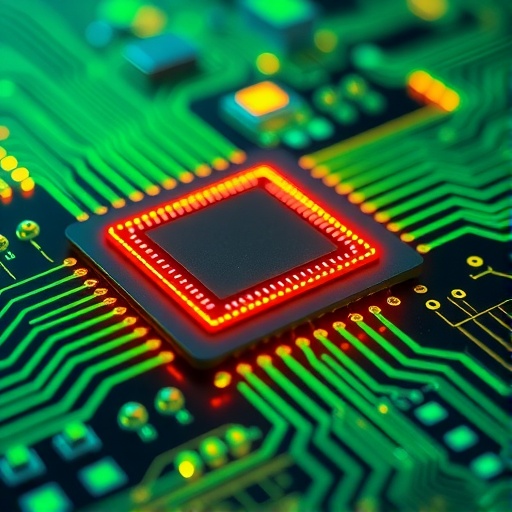Researchers at Kyushu University in Fukuoka, Japan, have made a significant advancement in the field of energy-efficient magnetic random-access memory (MRAM) technology. They have successfully developed a new fabrication method for this type of memory, employing a groundbreaking material known as thulium iron garnet (TmIG). This research is particularly timely as the increasing popularity of generative artificial intelligence (AI) has led to heightened energy demands from data centers globally. Consequently, there is an urgent need for high-speed, low-power computing hardware that can operate effectively at room temperature.
The urgency for innovative solutions in data processing cannot be overstated. As AI technologies evolve, they increasingly require more power, which leads to concerns about sustainability and energy efficiency in data centers that run these advanced computational workloads. Given this backdrop, the research conducted by Kyushu University offers a promising avenue to enhance computational hardware by potentially extending battery life and reducing overall energy consumption.
Central to the research is the spin-orbit torque (SOT) technology, which presents a new paradigm in memory storage. Unlike traditional methods that rely on magnets, SOT technology utilizes electrical currents to manipulate the orientation of microscopic magnetic elements within a thin film of material. This allows for faster information storage and retrieval compared to conventional memory technologies. Associate Professor Naoto Yamashita, the lead author of the study, emphasizes that TmIG is a particularly promising material due to its unique properties.
TmIG, initially discovered in Japan in 2012, presents a number of properties that make it suitable for use in MRAM devices. One of its key advantages is that it can efficiently generate spin-orbit torque when a thin platinum film is deposited on it and an electrical current is applied. However, the material has also been hindered by the challenges associated with producing high-quality thin films that are critical for viable memory applications.
To address these challenges, Yamashita and his team successfully implemented a mass production technique known as “on-axis magnetron sputtering.” This method allows for the generation of thin films atom by atom, effectively layering materials to achieve the desired thickness and quality. In their study, the researchers deposited a remarkably thin layer of three nanometers of platinum onto TmIG, which enabled them to manipulate the magnetic orientation of the material with a small electrical current.
The significance of this breakthrough lies in the efficiency of data writing, measured at 0.7 x 10^11 A/m², which rivals other films produced through conventional methods. This efficiency is crucial, given the intense demands for both speed and energy savings in modern computing applications. The researchers have, therefore, established a novel pathway for the fabrication of MRAM devices that not only perform better but are also more energy-efficient.
Furthermore, the research team recognizes that their findings contribute meaningfully to bridging the gap between theoretical research and practical application in high-performance memory technology. Their work is not merely an academic exercise; it has real-world implications that may soon translate into functional devices aimed at revolutionizing the information technology landscape.
“We are already in the process of developing functional devices that take advantage of our findings,” concludes Yamashita. The potential impact of this technology could significantly influence how data is stored and accessed for various applications, including those that facilitate the complexities of generative AI computations.
This research emphasizes Kyushu University’s commitment to fostering innovation and addressing pressing societal issues through advanced technology. As the world becomes increasingly interconnected and reliant on data, the strides made in energy-efficient computing will be pivotal in shaping a sustainable information society.
The message from this groundbreaking research is clear: by investing in innovative materials and methods, scientists can create technologies that not only drive advancements in computing performance but also contribute to a more energy-conscious future. The importance of continuing such research cannot be understated, particularly as we strive to meet the growing demands of the digital age.
The journey of TmIG extends beyond academic curiosity; it represents the potential to redefine memory storage technology and its application in various fields. The researchers at Kyushu University have taken an important step toward a future where high-speed computing does not come at the cost of energy efficiency, but instead offers synergies that enhance both capabilities.
In conclusion, this research paints an optimistic picture for the future of MRAM technology. Through the innovative use of thulium iron garnet, the possibility of more sustainable information management systems is not just a theory; it’s becoming a reality, backed by empirical research and potential industrial applications.
Subject of Research: Energy-efficient magnetic random-access memory (MRAM) technology using thulium iron garnet (TmIG).
Article Title: Deterministic spin-orbit torque switching of epitaxial ferrimagnetic insulator with perpendicular magnetic anisotropy fabricated by on-axis magnetron sputtering.
News Publication Date: 10-Oct-2025
Web References: Kyushu University, npj Spintronics.
References: Ngaloy, R. et al., npj Spintronics (2025).
Image Credits: Kyushu University/Naoto Yamashita.
Keywords
Energy-efficient MRAM, thulium iron garnet, spin-orbit torque, data centers, computing efficiency, sustainable technology, memory storage innovation.
Tags: AI energy demandsbattery life extension in computingenergy-efficient memory devicesinnovative data processing methodslow-power computing hardwaremagnetic random-access memory advancementsnext-generation memory storage solutionsreducing energy consumption in data centersroom temperature memory technologyspin-orbit torque technologysustainable data center solutionsthulium iron garnet applications





